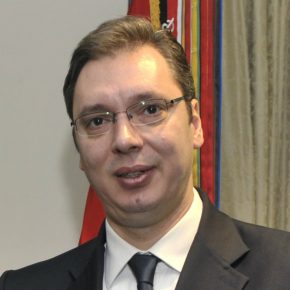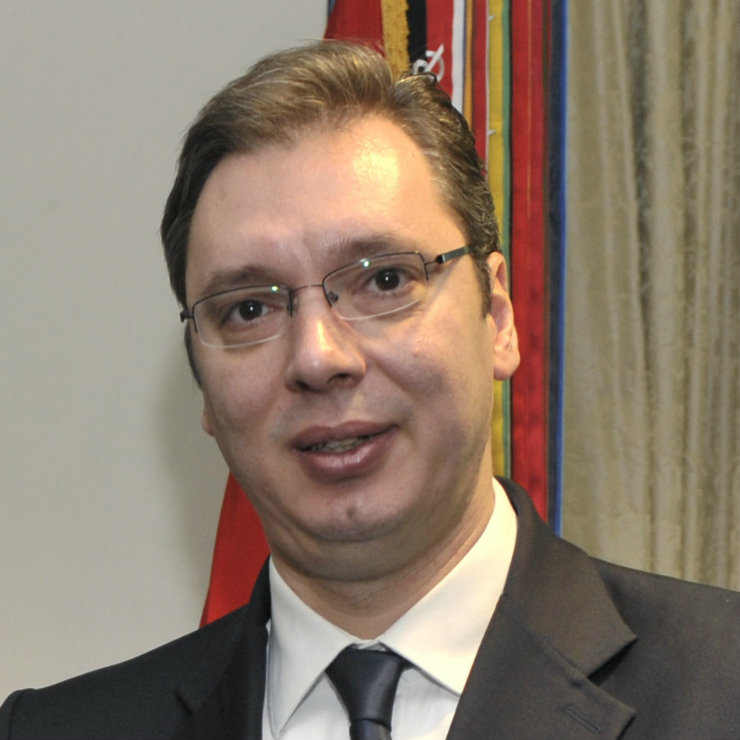
Aleksandar Vučić, Serbia's PM (BokicaK, CC BY)
The choice is not a simply one and the Serbian leaders balancing between the West and Kremlin have less and less room for manoeuvre. At the same time the dilemma creates a complex network of interdependent factors.
It’s all about money
When taking into account economic indicators, Serbia is closely linked to the Single European Market. Among the twenty one top export destinations of the Serbian products, seventeen are members of the European Union. Russia, Bosnia and Herzegovina, Montenegro and Macedonia were absorbing 23.2 per cent of Serbian exports and additional 3.5 per cent was sent to other non-EU states. EU market was destination for over 63 per cent of Serbian goods send abroad. Similar numbers indicate origins of Serbian imports. While 17.7 per cent of the Serbian imports came from the non-EU European states, the EU provided 65 per cent imported goods.
On the website of the delegation of the European Union to Serbia we find more facts confirming solid anchorage of the Serbian economy in the EU market: “The value of Serbian exports to the EU more than doubled from EUR1.2bn in 2009 to EUR3.2bn in 2015, (…). Over the years, Serbia’s exports to the EU have been growing faster than imports from the EU, resulting in a decreasing trade deficit and improving coverage of imports by exports on the Serbian side from below 50 per cent in 2009 (i.e. 50 per cent of imports from the EU were covered by exports from Serbia) to over 77 per cent in 2015”.
Almost half of Serbian agricultural export products are shipped to the European Union. “Around EUR100m of EU assistance have been delivered to the sector in Serbia since 2000, covering agriculture, rural development, food safety, and animal and plant health issues”. Moreover “A significant increase in support directly provided to rural recipients is planned for the years to come before EU accession, through what is known as the IPARD Programme (Instrument for Pre-accession Assistance in Rural Development). A sum of EUR175m will be offered in the form of grants to Serbian rural stakeholders to co-finance appropriate investments up to a maximum public contribution of 70 per cent of eligible expenditure”.
Among the largest companies in Serbia are: Belgian Delhaize, French Tarkett or Croatian Mercator. Since 2005 the value of FDI from the EU is EUR15bn, and amounts to 73 per cent of all investments in this country. Over the last 15 years, the EU donated, through various programmes and projects, additional EUR3bn.
Institutional ties
Serbian pro-European course of economy has been well anchored in numerous bilateral agreements. Almost all of them aimed at harmonisation of Serbian legislation with the EU requirements. This approximation was a prerequisite of development of further economic ties with the European Union, and then again, has been by these agreements reinforced.
In 2013 Stabilisation and Association Agreement enter into force. It constituted an important political, economic and institutional step towards full integration of Serbia within the EU. It meant that economic and political reforms were to be determined by the European Union, and the subsequent efforts of the Serbian authorities to be assessed in Brussels, Berlin and Paris. Political stabilisation should be accompanied by economic liberalisation and establishment of bilateral free trade area.
One could claim that Serbia, even if not member states of the EU (so far only 6 out of 35 negotiating chapters have been opened) is already integrated with the EU. It is difficult to imagine a sudden cut off from the European market, the EU investors and the EU assistance. Yet, the Serbian leaders keep on playing the Russian card by trying to balance between Moscow and Brussels. Or it would be more correct to say the Serbia is still being played by Moscow and Brussels.
The promises
The whole idea of integration with the EU is based on the potential Serbia’s membership. Today this prospect is distanced and blurred. So there is room for Russia’s involvement. Years of rather picturesque expressions of the Russian ambassador to Belgrade, plus some minor, yet well visible Russian investments in Serbia led to strong establishment of Russian foothold in the Balkans.
First of all, even if only in rhetorical terms, Russia supports Serbian resistance regarding recognition of independence of Kosovo. Russian veto in the UN Security Council prevented Kosovo from entering this organisation and to a large degree makes its international relations much more difficult, pushing it in fact to deep peripheries. Russian support was not as brotherly as one would think. It came at the high price. Moscow became a dominant player in energy (gas and oil) sector of Serbia, not only as the main deliverer of the resources but also as a producer and retailer.
Russian investments in Serbia remains very small comparing to the EU. As noted by Marta Szpala from the Centre for Eastern Studies (OSW): “in 2005–2013 Russia invested EUR598.4m in Serbia which is 4.5per cent of all foreign investments carried out over that period. Apart from the acquisition of NIS (one of the largest petroleum company in this region) there has been no significant inflow of large Russian investments to Serbia”.
In other words, the EU financed goods produced in Serbia need Russian fuel to reach European markets.
The MIGs
Russia promised delivery of six MiGs 29 to Serbian air forces, some tanks and armoured vehicles. Croatian daily Jutarnji List mentions even BUK missile system. Russian treats this assistance very seriously, expecting at the same time to establish official Russian military base near the Niš city in the southern Serbia, that today exists as a humanitarian aid depot. Russians would like to be able to move freely their equipment throughout the territory of Serbia – this right has been given to the NATO units.
Russian military base in the Balkans would limit operational abilities of NATO in the region. Serbia constitute a piece of a larger picture. “Russian President Vladimir Putin aims to maintain several “frozen states” in the Western Balkans to prevent Western integration, as is the case with Ukraine and Georgia. He encourages the autonomist RS entity to keep Bosnia divided and question its future as a single state. Likewise, Moscow backs Kosovo’s Serbian minority as a repressed nationality in order to uphold the spectre of partition. In Montenegro—a country on the verge of NATO accession—Kremlin proxies were reportedly behind a failed October coup attempt. Moscow also manipulates Macedonia’s internal turmoil and its obstructed path toward NATO and the EU by the persistent Greek veto”, states report of the Centre for European Policy Analysis
Can there be a pro-Russian Maidan?
As summarised in the CEPA paper, “Moscow promotes local nationalism to undermine support for Western institutions. It also corrupts national politicians to favour Russian business interests and fosters energy dependence to undergird diplomatic and political compliance and reduce Western investments. Moscow can also intensify its propaganda offensives through local media, the Internet and social networks to discredit Western institutions and encourage Eurosceptic and anti-American sentiments throughout the region.”
EU involvement in Serbia has been based on idea of deep economic integration and as such it has succeeded. Russia on the other hand leads much more proactive policy, which is very well visible, aggressive, assertive, and pointing at all the mistakes of the EU. Despite clear European superiority in terms of economic influence, Russia is still extending its area of influence. Today it is strong enough to organise a pro-Russian Maidan, in case Serbian leaders would opt for Brussels and Berlin.
Jan Muś is a lecturer at the Vistula University.


